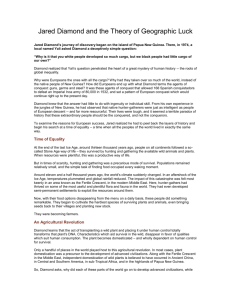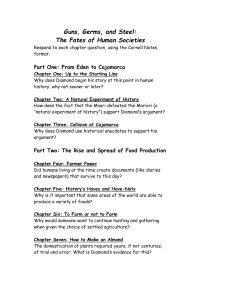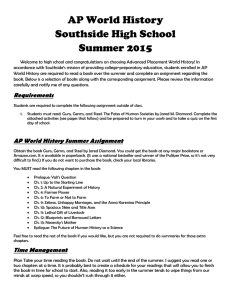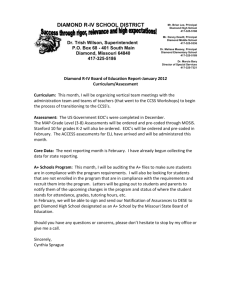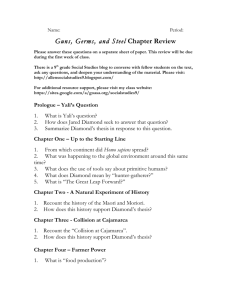Episode One : Out of Eden - Course
advertisement
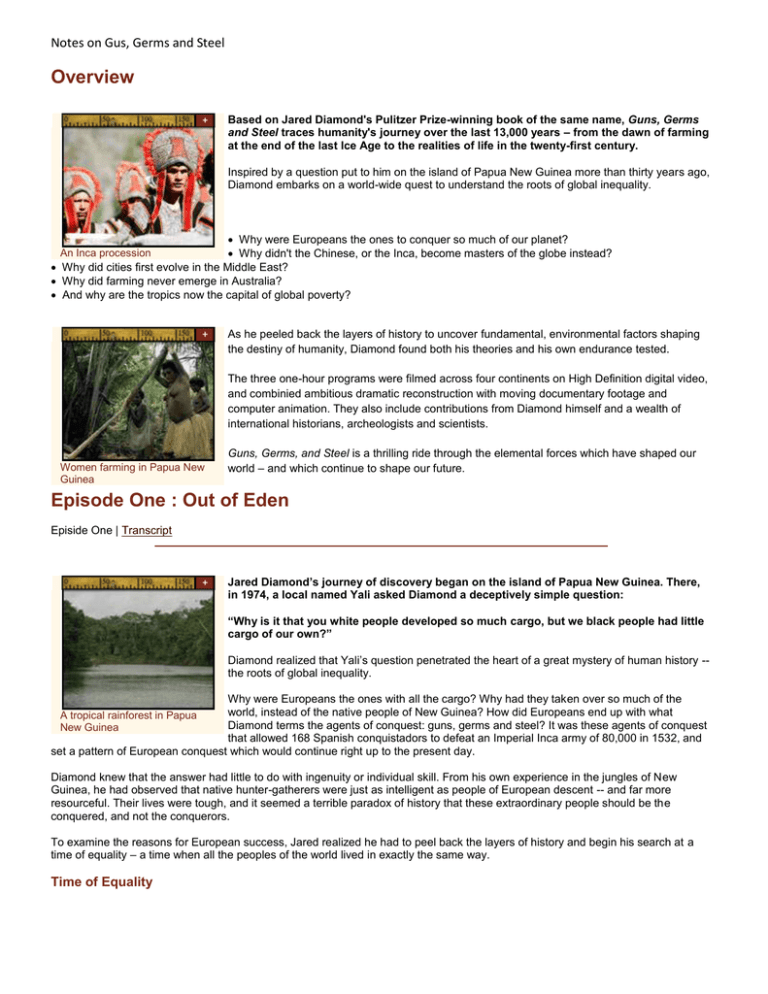
Notes on Gus, Germs and Steel Overview Based on Jared Diamond's Pulitzer Prize-winning book of the same name, Guns, Germs and Steel traces humanity's journey over the last 13,000 years – from the dawn of farming at the end of the last Ice Age to the realities of life in the twenty-first century. Inspired by a question put to him on the island of Papua New Guinea more than thirty years ago, Diamond embarks on a world-wide quest to understand the roots of global inequality. Why were Europeans the ones to conquer so much of our planet? Why didn't the Chinese, or the Inca, become masters of the globe instead? Why did cities first evolve in the Middle East? Why did farming never emerge in Australia? And why are the tropics now the capital of global poverty? An Inca procession As he peeled back the layers of history to uncover fundamental, environmental factors shaping the destiny of humanity, Diamond found both his theories and his own endurance tested. The three one-hour programs were filmed across four continents on High Definition digital video, and combinied ambitious dramatic reconstruction with moving documentary footage and computer animation. They also include contributions from Diamond himself and a wealth of international historians, archeologists and scientists. Women farming in Papua New Guinea Guns, Germs, and Steel is a thrilling ride through the elemental forces which have shaped our world – and which continue to shape our future. Episode One : Out of Eden Episide One | Transcript Jared Diamond’s journey of discovery began on the island of Papua New Guinea. There, in 1974, a local named Yali asked Diamond a deceptively simple question: “Why is it that you white people developed so much cargo, but we black people had little cargo of our own?” Diamond realized that Yali’s question penetrated the heart of a great mystery of human history -the roots of global inequality. Why were Europeans the ones with all the cargo? Why had they taken over so much of the world, instead of the native people of New Guinea? How did Europeans end up with what Diamond terms the agents of conquest: guns, germs and steel? It was these agents of conquest that allowed 168 Spanish conquistadors to defeat an Imperial Inca army of 80,000 in 1532, and set a pattern of European conquest which would continue right up to the present day. A tropical rainforest in Papua New Guinea Diamond knew that the answer had little to do with ingenuity or individual skill. From his own experience in the jungles of New Guinea, he had observed that native hunter-gatherers were just as intelligent as people of European descent -- and far more resourceful. Their lives were tough, and it seemed a terrible paradox of history that these extraordinary people should be the conquered, and not the conquerors. To examine the reasons for European success, Jared realized he had to peel back the layers of history and begin his search at a time of equality – a time when all the peoples of the world lived in exactly the same way. Time of Equality At the end of the last Ice Age, around thirteen thousand years ago, people on all continents followed a so-called Stone Age way of life – they survived by hunting and gathering the available wild animals and plants. When resources were plentiful, this was a productive way of life. But in times of scarcity, hunting and gathering was a precarious mode of survival. Populations remained relatively small, and the simple task of finding food occupied every waking moment. Around eleven and a half thousand years ago, the world's climate suddenly changed. In an aftershock of the Ice Age, temperatures plummeted and global rainfall reduced. The impact of this catastrophe was felt most keenly in an area known as the Fertile Crescent, in the modern Middle East. Here, hunter-gathers had thrived on some of the most useful and plentiful flora and fauna in the world. They had even developed semi-permanent settlements to exploit the resources around them. Now, with their food options disappearing from the menu on a daily basis, these people did something remarkable. They began to cultivate the hardiest species of surviving plants and animals, even bringing seeds back to their villages and planting new stock. They were becoming farmers. An Agricultural Revolution Diamond learns that the act of transplanting a wild plant and placing it under human control totally transforms that plant's DNA. Characteristics which aid survival in the wild, disappear in favor of qualities which suit human consumption. The plant becomes domesticated – and wholly dependent on human control for survival. Only a handful of places in the world played host to this agricultural revolution. In most cases, plant domestication was a precursor to the development of advanced civilizations. Along with the Fertile Crescent in the Middle East, independent domestication of wild plants is believed to have occurred in Ancient China, in Central and Southern America, in sub-Tropical Africa, and in the highlands of Papua New Guinea. Development of early farming in the Fertile Crescent So, Diamond asks, why did each of these parts of the world go on to develop advanced civilizations, while the farmers of New Guinea were apparently left behind? The luck of the draw Diamond discovers that the answer lies in a geographical luck of the draw – what mattered were the raw materials themselves. Of all the plant species in the world, only a limited number are possible, or useful, to domesticate. To Diamond's astonishment, most of these species are native to Europe and Asia – species like wheat, barley and rice, which grew wild in abundance in only these parts of the world. Two more species are native to Tropical Africa (sorghum and yams) while only one is native to the Americas (corn), and to Papua New Guinea (taro). Not a single domesticable plant grows wild in Australia. And that's not all. Diamond discovers a similar dramatic inequality in the distribution of domesticable animals. Animals dramatically increase the productivity of farming, through their meat, milk, leather, dung, and as beasts of burden. Without them, farmers are trapped in a cycle of subsistence and manual labor. 12 of the 14 domesticable animals in the world reside in Eurasia Of all the animal species in the world, only 14 have ever been domesticated. 12 of these are native to Eurasia. One, the llama, is native to South America – and the farmers of New Guinea managed to domesticate the pig. But pigs can't pull plows, and until the arrival of Europeans in the 20th century, all New Guinean farming was still done by hand. From tools to cities Diamond realized that the development of successful and productive farming, starting nearly 12,000 years ago in the Fertile Crescent, was the critical turning point in the origins of global inequality. From this point on, one group of people – the natives of Eurasia – would have a head start on the path to civilization. Successful farming provides a food surplus, and allows some people to leave the farm behind and develop specialized skills – such as metal-working, writing, trade, politics, and war-making. Plus, the simple geography of the continent of Eurasia – one coherent landmass spread on an east-west axis, with universal latitudes and climates – allowed these technologies and ideas to spread beyond the Middle East with ease. Without the environment, or the time, to develop similar skills, the farmers of New Guinea became trapped in their highland isolation. Diamond concludes that from the end of the Ice Age, geography ensured that different societies around the world would develop at different speeds. If Yali's people had had all the geographic advantages of Europeans, perhaps they could have conquered the world. Epilogue Diamond believes the blueprint for global inequality lies within the land itself, its crops and animals. But can this way of seeing the world really shed light on the great turning points of human history? Can Jared Diamond explain how a few hundred Europeans were able to conquer the New World, and begin an age of domination: the age of guns, germs and steel? Episode One : Out of Eden Episide One | Transcript Jared Diamond’s journey of discovery began on the island of Papua New Guinea. There, in 1974, a local named Yali asked Diamond a deceptively simple question: “Why is it that you white people developed so much cargo, but we black people had little cargo of our own?” Diamond realized that Yali’s question penetrated the heart of a great mystery of human history -the roots of global inequality. Why were Europeans the ones with all the cargo? Why had they taken over so much of the world, instead of the native people of New Guinea? How did Europeans end up with what A tropical rainforest in Papua Diamond terms the agents of conquest: guns, germs and steel? It was these agents of conquest New Guinea that allowed 168 Spanish conquistadors to defeat an Imperial Inca army of 80,000 in 1532, and set a pattern of European conquest which would continue right up to the present day. Diamond knew that the answer had little to do with ingenuity or individual skill. From his own experience in the jungles of New Guinea, he had observed that native hunter-gatherers were just as intelligent as people of European descent -- and far more resourceful. Their lives were tough, and it seemed a terrible paradox of history that these extraordinary people should be the conquered, and not the conquerors. To examine the reasons for European success, Jared realized he had to peel back the layers of history and begin his search at a time of equality – a time when all the peoples of the world lived in exactly the same way. Time of Equality At the end of the last Ice Age, around thirteen thousand years ago, people on all continents followed a so-called Stone Age way of life – they survived by hunting and gathering the available wild animals and plants. When resources were plentiful, this was a productive way of life. But in times of scarcity, hunting and gathering was a precarious mode of survival. Populations remained relatively small, and the simple task of finding food occupied every waking moment. Around eleven and a half thousand years ago, the world's climate suddenly changed. In an aftershock of the Ice Age, temperatures plummeted and global rainfall reduced. The impact of this catastrophe was felt most keenly in an area known as the Fertile Crescent, in the modern Middle East. Here, hunter-gathers had thrived on some of the most useful and plentiful flora and fauna in the world. They had even developed semi-permanent settlements to exploit the resources around them. Now, with their food options disappearing from the menu on a daily basis, these people did something remarkable. They began to cultivate the hardiest species of surviving plants and animals, even bringing seeds back to their villages and planting new stock. They were becoming farmers. An Agricultural Revolution Diamond learns that the act of transplanting a wild plant and placing it under human control totally transforms that plant's DNA. Characteristics which aid survival in the wild, disappear in favor of qualities which suit human consumption. The plant becomes domesticated – and wholly dependent on human control for survival. Only a handful of places in the world played host to this agricultural revolution. In most cases, plant domestication was a precursor to the development of advanced civilizations. Along with the Fertile Crescent in the Middle East, independent domestication of wild plants is believed to have occurred in Ancient China, in Central and Southern America, in sub-Tropical Africa, and in the highlands of Papua New Guinea. Development of early farming in the Fertile Crescent So, Diamond asks, why did each of these parts of the world go on to develop advanced civilizations, while the farmers of New Guinea were apparently left behind? The luck of the draw Diamond discovers that the answer lies in a geographical luck of the draw – what mattered were the raw materials themselves. Of all the plant species in the world, only a limited number are possible, or useful, to domesticate. To Diamond's astonishment, most of these species are native to Europe and Asia – species like wheat, barley and rice, which grew wild in abundance in only these parts of the world. Two more species are native to Tropical Africa (sorghum and yams) while only one is native to the Americas (corn), and to Papua New Guinea (taro). Not a single domesticable plant grows wild in Australia. And that's not all. Diamond discovers a similar dramatic inequality in the distribution of domesticable animals. Animals dramatically increase the productivity of farming, through their meat, milk, leather, dung, and as beasts of burden. Without them, farmers are trapped in a cycle of subsistence and manual labor. 12 of the 14 domesticable animals in the world reside in Eurasia Of all the animal species in the world, only 14 have ever been domesticated. 12 of these are native to Eurasia. One, the llama, is native to South America – and the farmers of New Guinea managed to domesticate the pig. But pigs can't pull plows, and until the arrival of Europeans in the 20th century, all New Guinean farming was still done by hand. From tools to cities Diamond realized that the development of successful and productive farming, starting nearly 12,000 years ago in the Fertile Crescent, was the critical turning point in the origins of global inequality. From this point on, one group of people – the natives of Eurasia – would have a head start on the path to civilization. Successful farming provides a food surplus, and allows some people to leave the farm behind and develop specialized skills – such as metal-working, writing, trade, politics, and war-making. Plus, the simple geography of the continent of Eurasia – one coherent landmass spread on an east-west axis, with universal latitudes and climates – allowed these technologies and ideas to spread beyond the Middle East with ease. Without the environment, or the time, to develop similar skills, the farmers of New Guinea became trapped in their highland isolation. Diamond concludes that from the end of the Ice Age, geography ensured that different societies around the world would develop at different speeds. If Yali's people had had all the geographic advantages of Europeans, perhaps they could have conquered the world. Epilogue Diamond believes the blueprint for global inequality lies within the land itself, its crops and animals. But can this way of seeing the world really shed light on the great turning points of human history? Can Jared Diamond explain how a few hundred Europeans were able to conquer the New World, and begin an age of domination: the age of guns, germs and steel? Episode Two : Conquest Episode Two | Transcript On November 15th 1532, 168 Spanish conquistadors arrive in the holy city of Cajamarca, at the heart of the Inca Empire, in Peru. They are exhausted, outnumbered and terrified – ahead of them are camped 80,000 Inca troops and the entourage of the Emperor himself. Yet, within just 24 hours, more than 7,000 Inca warriors lie slaughtered; the Emperor languishes in chains; and the victorious Europeans begin a reign of colonial terror which will sweep through the entire American continent. Why was the balance of power so unequal between the Old World, and the New? Can Jared Diamond explain how America fell to guns, germs and steel? Two Empires Spaniard Francisco Pizarro has gone down in history as the man who conquered the Inca. Leading a small company of mercenaries and adventurers, this former swineherd from a provincial town in Spain managed to demolish one of the most sophisticated Empires the world has ever seen. From Pizarro's home town of Trujillo, Jared Diamond pieces together the story of the Spaniards' victory over the Inca, tracing the invisible hand of geography. Pizarro, leader of the Spanish conquistadors On the surface, the Spaniards had discovered a foreign empire remarkably similar to their own. The Inca had built an advanced, politically sophisticated, civilization on the foundations of successful agriculture. They had ruthlessly conquered their neighbors in South America, and by 1532 governed a vast territory, the length and breadth of the Andes. But as Jared discovers, the Inca lacked some critical agents of conquest. Horses vs Llamas Eurasia boasted 13 of the 14 domesticable mammals in the world as native species. Among these was the horse. As Diamond learns, the horse was fundamental to the farming success of Eurasian societies, providing not only food and fertilizer but also, crucially, load-bearing power and transport – transforming the productivity of the land. The only non-Eurasian domesticable animal species in the world was the llama – native, by chance, to South America. The Inca relied on llamas for meat, wool and fertilizer – but the llama was not a load-bearing animal. Llamas can't pull a plow, nor can they transport human beings. And unlike horses, llamas could never be ridden for war. Spanish horsemanship, based on principles of cattle-herding, was famous throughout Europe for its manoeuvrability and spontaneity – skills learned by Pizarro's conquistadors in their youth. Horses could charge, mounted soldiers could slay with brutal efficiency. Diamond realizes that, to a people like the Inca, who had never seen humans ride animals before, the psychological impact of these alien mounted troops must have been huge. Steel vs bronze But Pizarro's men only brought 37 horses to Peru. So where did the rest of their shock value lie? Well, once again, the Europeans had something the Americans didn't – they had steel. For thousands of years throughout Eurasia, metal-working technology had evolved from the simplest ore-extraction of the first Neolithic villages, to the highly-sophisticated forging of steel, in cities like Toledo and Milan. Geography had endowed Europe with rich sources of iron and wood, and a climate conducive to high-temperature metallurgy. Thanks to the geographic ease with which ideas spread through the continent of Eurasia, discoveries like gunpowder could also migrate thousands of miles, from China to Spain. And political competition within Europe fuelled a medieval arms race. Pizarro's conquistadors were armed with the latest and greatest in weapons technology – guns, and swords. The Inca, by comparison, had never worked iron or discovered the uses of gunpowder. Geography had not endowed them with these resources. Nor had they received technologies from other advanced societies within the Americas. This included a technology even more critical to Spanish success than their weapons, writing. Writing On the eve of battle, Pizarro and his men discuss how to tackle the vast army of the Inca. It seems an impossible task. But they have a secret weapon up their sleeve – the weapon of past experience. Jared Diamond travels to the library of Salamanca University, to read for himself the published accounts of Hernan Cortes' conquest of Mexico. Only twelve years before Cajamarca, Cortes and his men had faced similar odds against the vast army of the Aztec Empire. But somehow Cortes had captured the Emperor and conquered the land for Spain. Cortes and his soldiers sent their written accounts back to the general public in Europe, where they were widely published. Diamond discovers a repository of dirty tricks at Salamanca – a collection of handbooks for would-be conquistadors. And on the eve of battle, it was the printed lessons of Cortes that inspired Pizarro and his men. By contrast, the Inca Emperor Atahualpa had never heard of Cortes, or even of his own neighbors, the Aztecs. Thanks to the geography of the Americas, it was practically impossible for any ideas, technologies, or even news, to spread from north to south. So whilst the Mayan civilisation of Central America had invented a form of written communication, it had never got as far as Peru. The Inca were isolated – and Atahualpa had never even seen a book before. Showdown So, when presented with a copy of the Bible on November 16th, 1532, Atahuallpa throws the alien object to the floor, prompting a furious and surprise attack from the conquistadors. The combined impact of mounted troops, gunpowder and sharpened steel lead to a massacre, and Atahuallpa is personally seized by Pizarro himself. In a matter of hours, the Inca Empire lies in ruins. But the story of Eurasian triumph isn't over. Lethal gift of livestock Inca Emperor Atahualpa had never seen writing Seven thousand Inca died at Cajamarca. Over the course of a generation, the Spaniards killed tens of thousands more. But Diamond learns that up to 95% of the native population of the entire Americas were wiped out after the conquest. Genocide alone can't account for this number. Instead, he discovers, native Americans fell victim to European germs – infections which they had never encountered before. And Diamond realizes that European diseases like smallpox were a fatal inheritance of thousands of years of mammal domestication – the lethal gift of livestock. European farmers, rearing cattle, pigs, sheep, goats, horses and donkeys, lived in close proximity with their animals - breathing, eating and drinking animal germs. Eventually some diseases crossed over to the human population and the resulting epidemics wiped out millions of Europeans. But each time, a few people would survive and the immunities they'd developed passed through their genes to the next generation. The conquistadors who sailed to the Americas carried immunities like these. But in Peru, the llama was never brought indoors, and never milked so the prospect for the spread of disease was severely reduced. But then the Europeans arrived and a single Spanish slave arrived, infected with smallpox and the consequences were devastating. The disease emptied the continent, killing millions of indigenous people who lacked any prior exposure, and therefore any immunity. The European triumph was complete. So Diamond has shown how guns, germs and steel had conquered the New World. But will his theories work in every corner of the globe? Episode Three : Into the Tropics Episide Three | Transcript So far, Jared Diamond has demonstrated how geography favoured one group of people – Europeans – endowing them with agents of conquest ahead of their rivals around the world. Guns, germs and steel allowed Europeans to colonize vast tracts of the globe – but what happened when this all-conquering package arrived in Africa, the birthplace of humanity? Can Jared Diamond's theories explain how a continent so rich in natural resources, could have ended up the poorest continent on earth? Guns Germs and Steel triumph again...? Jared's journey begins on a steam train in Cape Town, designed to carry civilization to the heart of the so-called 'dark continent'. In the Cape, Jared discovers a landscape and way of life that feels very European – farms growing cattle, wheat, grapes and barley; settler communities dating back over three hundred years. He realizes that the first European settlers in southern Africa were dealt a very lucky hand by geography – they landed in one of the few temperate zones of the southern hemisphere – a climate to which their crops an animals were ideally suited. These foundations of their historical success worked for them even 6,000 miles from home and they were able to sweep aside the indigenous hunting communities with ease – assisted by the impact of European germs. But these settlers were not ones to stand still. A mass migration known as the Great Trek took thousands of Dutch settlers north and east – into unknown territory – and, as they found to their cost, into Zulu land. The Zulus had built a sophisticated African state based on military conquest – and now they resisted European invasion. But eventually, overcoming the limitations of their weapons and inheriting new, automatic weapons form industrialized Europe, the settlers triumphed over their rival African tribes - at the cost of thousands of lives. Jared observes that the story of Guns, Germs and Steel seems to be unfolding all over again. But having swept aside native opposition beyond the cape, Jared asks, could the settlers build a new life of their own? Enter the Tropics As the settlers traveled further north, life suddenly became a lot harder. The foundations of their success, their crops and animals, refused to grow. They were forced to barter for food from their neighbours. And they started to fall ill with a mysterious and terrifying fever. It was a complete reversal of the usual pattern of European conquest. So what had changed? Reconstruction: A European settler suffers from malaria in colonial Africa Jared realizes that, unlike elsewhere in the world - where Europeans had landed in a temperate zone and traveled from east to west, maintaining similar climates - here in Africa, Europeans landed in the south and migrated north, moving through latitude zones and experiencing radically different climates. In fact, as they crossed the Limpopo River, they had entered the Tropics. Temperate crops such as wheat simply can't survive in a tropical climate. Nor can European animals – plagued by the diseases which thrive in the Tropics. But all around them, Europeans could see successful, agricultural Africans growing their own crops, farming their own animals. How could they do this? Jared sets out to learn more about the secrets of tropical Africa. The African Story Stopping off in a school, Jared discovers that the enormous diversity of modern tropical Africa is reflected in the hundreds of languages still spoken across the continent – many of which are mastered by kids at a very young age. But the inherent similarity of these languages indicates a common ancestral root – a single language spoken by a group of ancient tropical farmers from the Niger-Congo region, who have come to be known as Bantu. About 5,000 years ago, these Bantu farmers began to spread beyond their native north-west region, moving into new lands, picking up crops and animals as they went. Eventually, Bantu culture spread across most of tropical Africa, reaching as far as the Zulu territories of the south. Physical evidence for this vast tropical diaspora is scant, but archaeologists have found clues at a site on the banks of the Limpopo known as Mapungubwe – the place of the jackal. Here there is evidence for a complex, agricultural state supporting thousands of people throughout southern Africa – farming sorghum and cattle, forging iron, exporting gold and tin and importing exotic materials and precious stones from as far away as India and China. The discovery of Mapungubwe overturned centuries of prejudice about African history and proved the continent played host to a sophisticated tropical civilization centuries before the arrival of Europeans. But, Jared wonders, how did the Africans achieve all this in a climate tailor-made for the spread of disease? Germs reversed Elsewhere in the world, European germs laid the foundations for European conquest -decimating native populations who had no previous exposure to diseases like smallpox. But in tropical Africa, the indigenous peoples seemed to survive both imported European germs, and the tropical fevers which were decimating European settlers. Jared discovers that smallpox in fact may have evolved in tropical Africa – and had certainly been present in the continent for thousands of years. So African cattle-farmers had evolved antibodies and immunities similar to their European rivals; they had even invented methods of smallpox vaccination, conferring immunity for life. And their lifestyles were designed to avoid infection from mosquitoes, carriers of the deadly malaria parasite. Over centuries of exposure, tropical Africans evolved degrees of physical immunity to the worst effects of this tropical disease. But they also learned to live in high or dry locations, away from the natural habitat of the mosquito, and to limit the level of disease transmission by keeping their communities relatively small. African civilization had evolved strategies which helped them survive – even thrive – in the topics. So, Jared asks, where did this civilization go? An Empire robbed Geography endowed Africa with one last temptation for European colonizers – natural resources, like copper, diamonds and gold. So, unable to build their own societies in the tropics, European governments turned to cheap African labour instead to maximize the profit from these resources. Over the course of two generations, brutal regimes throughout central Africa ripped tropical civilization to shreds. They tore men women and children from their homes, and forced them to live and work together in the pursuit of industrial raw materials. Jared discovers that the very tracks of steel on which he has been riding throughout his journey, were built on the back of this colonial exploitation. And the legacy these regimes left behind? A continent plagued by disease. When colonial governments destroyed a way of life built up over thousands of years, they left tropical Africans naked to the forces of their environment. Today, diseases like malaria are resurgent throughout tropical Africa – malaria is still the number one killer of African children under 5-years-old. Brought to a children's hospital in Zambia, Jared discovers for himself the tragic consequences of this disease. Possible futures...? So, Jared concludes, what has his epic journey through world history taught him, after all? That modern global inequalities have been shaped by geography's influence over our history. That geography – and advantages such as guns, germs and steel – are the great forces that have shaped the history of our world and continue to shape the experience of countries like Zambia. But does that mean that Jared is a determinist? That he believes the peoples of the world are destined to follow their geographic destiny, for either good or bad? Well, no – and for countries like Zambia, there is light at the end of the tunnel. Other tropical nations have managed to lift the burden of diseases like malaria. Government-funded research, new drugs, even a vaccine, today offer hope to the people of Zambia. Jared concludes that we can only achieve a better future if we have a more comprehensive understanding of our past. Only by recognizing the role which geography, and our environment, have played in our history, can we begin to overcome today's problems. Because while geography and history may give us our start in life, they should never dictate our destiny.

